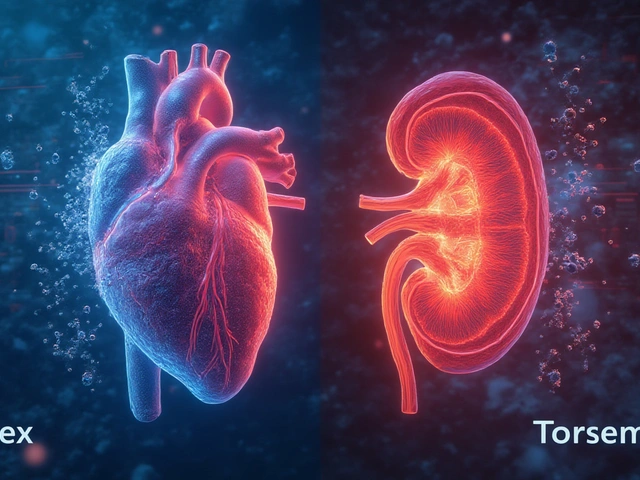Antipsychotic Selection Tool
Which Antipsychotic is Right for Your Patient?
This tool helps guide selection based on patient characteristics, side-effect profile, and clinical priorities. It's designed for clinicians and healthcare professionals.
Key Takeaways
- Mellaril (Thioridazine) is an older low‑potency typical antipsychotic with a higher risk of cardiac side effects.
- Newer atypical agents such as Risperidone and Olanzapine generally offer better metabolic profiles and fewer movement disorders.
- Haloperidol remains the go‑to high‑potency typical drug for acute agitation but demands careful monitoring for extrapyramidal symptoms.
- Quetiapine and Clozapine are useful for treatment‑resistant cases, though Clozapine requires strict blood‑count surveillance.
- Choosing the right medication hinges on symptom severity, side‑effect tolerance, comorbid conditions, and monitoring capacity.
When a clinician says “let's switch your antipsychotic,” the decision usually involves weighing efficacy against safety. Mellaril (Thioridazine) often pops up because it’s cheap and effective for certain patients, but it’s not the only game in town. This article breaks down how Thioridazine stacks up against the most common alternatives, giving you a clear picture of when each drug might be the best fit.
What Is Mellaril (Thioridazine)?
Mellaril (Thioridazine) is a low‑potency typical antipsychotic belonging to the phenothiazine class, originally approved in the 1960s for the treatment of schizophrenia and psychotic disorders. It works by blocking dopamine D2 receptors, which reduces the over‑activity that contributes to hallucinations and delusions. Because it also blocks histamine, muscarinic, and alpha‑adrenergic receptors, patients often notice sedation, dry mouth, and orthostatic dizziness.
Typical adult dosing starts at 50mg twice daily, with a usual maintenance range of 200-800mg per day. The drug is taken with food to improve absorption, and plasma levels should be checked after a week of steady dosing.
Key safety concerns include QT‑interval prolongation, which can lead to life‑threatening arrhythmias, and a modest risk of extrapyramidal symptoms (EPS). For that reason, many regulators have restricted its use to patients who have failed newer agents or who cannot afford them.
Common Alternatives to Thioridazine
Below are the six most frequently prescribed antipsychotics that clinicians consider instead of Thioridazine.
Risperidone is an atypical (second‑generation) antipsychotic that blocks dopamine and serotonin receptors, offering good efficacy for both positive and negative symptoms of schizophrenia.
Olanzapine belongs to the thienobenzodiazepine class and provides strong antipsychotic action with a higher propensity for weight gain and metabolic changes.
Haloperidol is a high‑potency typical antipsychotic; it is very effective for acute agitation but carries a higher risk of EPS and tardive dyskinesia.
Quetiapine is a low‑potency atypical agent often used for its sedating properties and for patients with co‑occurring mood disorders.
Clozapine is reserved for treatment‑resistant schizophrenia; it dramatically reduces psychosis but requires regular blood‑count monitoring because of agranulocytosis risk.
All of these drugs are indicated for schizophrenia, but each carries a distinct side‑effect fingerprint that shapes prescribing decisions.

Side‑Effect Profiles at a Glance
| Drug | Potency (Typical vs Atypical) | Key Efficacy | Major Side‑Effects | QT‑Prolongation Risk | Cost (UK NHS 2025) |
|---|---|---|---|---|---|
| Mellaril (Thioridazine) | Low‑potency typical | Effective for positive symptoms | Sedation, anticholinergic, EPS (moderate) | High | £0.12 per tablet |
| Risperidone | Atypical | Broad efficacy, good for negative symptoms | Prolactin elevation, mild EPS | Low | £0.45 per tablet |
| Olanzapine | Atypical | Strong antipsychotic effect | Weight gain, metabolic syndrome | Low | £0.55 per tablet |
| Haloperidol | High‑potency typical | Excellent for acute agitation | High EPS, tardive dyskinesia | Very Low | £0.10 per tablet |
| Quetiapine | Atypical (low potency) | Good for psychosis with insomnia | Sedation, orthostatic hypotension | Low | £0.38 per tablet |
| Clozapine | Atypical (unique) | Best for treatment‑resistant cases | Agranulocytosis, seizures, myocarditis | Moderate | £0.70 per tablet |
Decision‑Making Criteria
Choosing the right antipsychotic isn’t a one‑size‑fits‑all exercise. Below is a quick decision tree you can run through with a patient:
- Is the patient at high risk for cardiac issues? If yes, steer clear of Thioridazine and other QT‑prolonging drugs.
- Do they need rapid calm‑down for severe agitation? Haloperidol or a short‑acting injectable may be preferable.
- Are metabolic concerns (obesity, diabetes) a priority? Avoid Olanzapine; consider Risperidone or Quetiapine.
- Has the patient tried at least two other antipsychotics without success? Clozapine becomes the evidence‑based option.
- Is cost a major barrier? Thioridazine and Haloperidol are the cheapest, but you must weigh that against safety.
Remember that each medication also interacts with other drugs. Thioridazine, for instance, can boost serum levels of certain CYP2D6 substrates, such as metoprolol, leading to unexpected bradycardia.
Monitoring and Follow‑Up
Regardless of the drug chosen, regular monitoring improves outcomes.
- Schizophrenia requires baseline and periodic assessment of symptom severity using tools like the PANSS scale.
- EKG should be repeated after initiating Thioridazine, especially in patients over 50 or with existing heart disease.
- Blood glucose and lipid panels are essential when prescribing Olanzapine or Quetiapine.
- Weekly absolute neutrophil counts are mandatory for Clozapine during the first 18 weeks.
- Prolactin levels should be checked if Risperidone causes galactorrhea or menstrual irregularities.
Pros and Cons Summary
Below is a concise snapshot of when each drug shines or falls short.
| Drug | Best For | Avoid When |
|---|---|---|
| Mellaril (Thioridazine) | Low cost, patients tolerant of sedation | History of cardiac arrhythmias, need for rapid symptom control |
| Risperidone | Balanced efficacy, manageable side‑effects | Severe prolactin‑related issues |
| Olanzapine | Strong antipsychotic effect in acute relapse | Obesity, diabetes, metabolic syndrome |
| Haloperidol | Acute agitation, inpatient settings | Patients prone to EPS or tardive dyskinesia |
| Quetiapine | Patients with insomnia or comorbid mood disorder | Those needing high potency control |
| Clozapine | Treatment‑resistant schizophrenia | Patients unable to attend regular blood‑test appointments |
Frequently Asked Questions
Is Thioridazine still prescribed in the UK?
Yes, but its use is limited to patients who have not responded to newer atypical agents and who have no contraindications for QT‑prolongation. Most clinicians reserve it for cost‑sensitive settings.
How does the efficacy of Thioridazine compare with Risperidone?
Clinical trials from the 1990s show comparable reduction in positive symptoms, but Risperidone offers a lower risk of cardiac events and a more favorable side‑effect profile overall.
Can Thioridazine be used with other psychotropics?
Caution is advised. Thioridazine inhibits CYP2D6, so combining it with drugs like fluoxetine or paroxetine can raise serum levels of both medications, increasing side‑effect risk.
What monitoring is required for QT‑prolongation?
Baseline ECG before starting, then repeat after 1week and after any dose increase. Discontinue if QTc exceeds 500ms or if the patient experiences syncope.
Is there any situation where Thioridazine is the preferred choice?
In low‑resource settings where newer atypicals are unavailable or unaffordable, Thioridazine may be the only viable option, provided cardiac monitoring can be arranged.








Miriam Rahel October 17, 2025
Thioridazine's primary limitation lies in its propensity to prolong the QT interval, rendering it unsuitable for patients with pre‑existing cardiac disease; alternative agents such as risperidone or olanzapine exhibit considerably lower cardiotoxic risk.
Samantha Oldrid October 23, 2025
Oh sure, because ignoring decades of cardiac warnings has always worked out so well.
lisa howard October 29, 2025
Honestly, when I first read about thioridazine I thought it was a relic from a bygone era, a ghost of psychopharmacology that somehow survived the ruthless march of modern medicine, and yet here we are, still debating its place in the formulary. The specter of QT prolongation looms like a storm cloud over every prescription, and clinicians are forced to balance that dread against the drug's cheap price tag, which, frankly, feels like being asked to choose between a leaky roof and a broken fridge. Patients, meanwhile, are caught in the middle, their lives hanging on a delicate filament of dosage adjustments and frantic ECG follow‑ups. I have watched families gather around the bedside, counting heartbeats like a grim metronome, while nurses scramble to secure an extra monitor for the night shift. The drama of it all is amplified when insurance companies balk at covering newer, pricier agents, pushing doctors to resurrect thioridazine like a last‑ditch lifeline. Every time a new study surfaces showing a marginal benefit of a newer atypical, the debate reignites, and the old arguments resurface with renewed vigor. It's as if the entire psychiatric community is stuck in an endless loop of cost versus safety, each side shouting over the other in a cacophony of statistical citations. Meanwhile, the underlying biology of schizophrenia remains stubbornly complex, reminding us that no single pill can be a panacea. In my experience, the most striking thing is how quickly the conversation shifts from scientific nuance to political theatre, with stakeholders lobbying for their preferred outcomes. All the while, patients' quality of life teeters on the edge, waiting for a decision that feels both bureaucratic and profoundly personal. So, when we finally settle on a medication, it's rarely because one drug is objectively superior, but because the system has forced a compromise. And that, dear readers, is the tragic irony of thioridazine's continued existence in modern practice.
Cindy Thomas November 3, 2025
While the cost advantage of thioridazine is undeniable, the hidden expenses of cardiac monitoring often outweigh the savings 🙂. Moreover, patient adherence can suffer when side‑effects such as sedation become intolerable. A nuanced approach that weighs both financial and physiological factors is essential.
Kate Marr November 9, 2025
Our healthcare system should prioritize efficacy over cheapness, and importing foreign‑made cheap psychotropics only hinders progress 🇺🇸.
James Falcone November 15, 2025
Listen, if you want a drug that actually works without blowing up the heart, stick with the home‑grown options that our vets swear by.
Frank Diaz November 21, 2025
One could argue that the very act of choosing a medication is a microcosm of humanity's endless quest for control, yet many succumb to the illusion of safety offered by legacy drugs.
Valerie Vanderghote November 27, 2025
Let me tell you, the whole saga of thioridazine feels like a never‑ending soap opera where each episode introduces a new twist of side‑effects, dosing dilemmas, and bureaucratic red tape. First, there’s the ever‑present threat of QT prolongation, a ticking time bomb that keeps cardiologists up at night. Then, the sedation that drags patients into a haze so thick you’d think they were under a permanent fog. Add to that the cost factor, which makes hospitals scramble for budget approvals like a desperate treasure hunt. Meanwhile, insurance companies wave their pens and say “no” to newer atypicals, forcing clinicians back onto this aging drug like an actor forced to reprise a role they’ve outgrown. The nurses, bless them, have to juggle ECGs, blood pressure checks, and patient complaints about feeling like a zombie, all while trying to keep a smile on their face. Families sit in waiting rooms, clutching pamphlets that describe the same side‑effects in a thousand different ways, hoping for a miracle. And throughout all this, the pharmaceutical reps whisper about “better alternatives” that are just out of reach for most. In the end, the entire process becomes a theater of compromise, where safety, efficacy, and economics perform a clumsy dance that leaves everyone exhausted and uncertain. So, when you hear someone praise thioridazine as the cheap savior, remember the backstage chaos that makes that praise sound more like a tragic ode than a triumph.
Michael Dalrymple December 2, 2025
It's crucial to remember that each antipsychotic represents a tool in the clinician's toolbox; selecting the right one involves collaboration, patient education, and diligent follow‑up. By integrating evidence‑based guidelines with individual preferences, we can optimize outcomes while minimizing adverse effects.